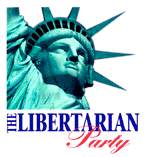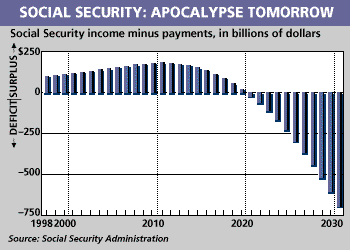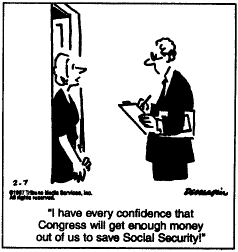Social Security reform remains high (not high enough) on the
congressional agenda. But is
it too risky to take the system private, as some critics of reform plans
say?
Backers of privatization say that it would enable every American build a nest egg - real wealth that could be used for retirement or passed on to heirs. Also, supporters say that investing payroll taxes privately will lead to a boom in capital formation and economic growth.
Harvard University economist Martin Feldstein, who was chairman of President Reagan's Council of Economic Advisers, projects that taking Social Security completely private would boost Gross Domestic Product (GDP) by roughly $400 billion a year.
Critics cite several reasons to reject the privatization of Social Security:
- Workers who aren't seasoned investors might not handle their own money wisely.
- Brokers' fees and other hidden costs could cut into investors' gains.
- A private system may well widen the gap between rich and poor.
Who's right: the reformers or the critics?
Fortunately, other countries can serve as models for private pension reforms. In the 1980s, Chile and Great Britain formulated plans that resemble proposals now before Congress. How are these plans designed - and how have retirees fared under them?
Chile
In 1980, Chile became the first country to privatize its public pension system. Under the new system, workers have 10% of their wages deducted from their paychecks and deposited into Pension Savings Accounts (PSAs). PSAs are managed by Pension Fund Administrators (AFPs). Each AFP can run only one PSA, but workers can switch their accounts from one AFP to another. Workers have choice. What a novel idea !
Workers must contribute roughly an extra 3% of wages for life and disability insurance. Self-employed workers don't have to participate in the system.
Older workers who put money into a PSA but haven't amassed enough wealth to retire qualify for a government pension that's a percent of the average wage. Poor, self-employed workers who don't enter the retirement system can get welfare.
The Chilean government tightly regulates the AFPs. The state sets minimum and maximum rates of return based on the average performance of each plan, says Sebastian Edwards, an economist at the University of California, Los Angeles.
If one plan's portfolio performs much better than average, the excess must be set aside in a profitability reserve, which is used to pay retirees if the fund has a downturn in the future.
Also, AFPs are required to invest conservatively. In the early 1980s, Edwards says, funds invested almost entirely in government securities. Over time, the rules have been relaxed. AFPs can now put small amounts in real estate and foreign equities.
The new system has delivered high returns. From 1981 to 1998, the , after adjusting for inflation, was . But there have been peaks and valleys. For example, in 1982 and 1991 real returns soared to roughly 30%. In 1995 and 1998, the AFPs saw losses.
Because the Chilean government strictly controls the AFPs - and requires them to make similar kinds of investments - there isn't enough consumer choice. There are only about 15 AFPs in Chile, and their portfolios are nearly identical. "The AFPs have every incentive to copy one another," said Stephen Kay, an analyst with the Latin American Research Group of the Federal Reserve Bank of Atlanta.
Marc Cooper, who was an interpreter for former Chilean President Salvador Allende from 1971 to 1973, says that, since AFPs can't compete with each other on the merits of their portfolios, they use other tactics to attract investors. "Some companies are offering toasters to people who switch their accounts. Others are offering bicycles," Cooper said.
"(The) Chilean system doesn't really get at the important question: If we gave people more choice, how would they handle it?" said Stephen Zeldes, a business professor at Columbia University. For the typical Chilean, one AFP is just about as good as another. "It's pretty hard to go wrong in Chile," Zeldes said.
The Chilean system had relatively high start-up costs. In 1983, fees and commissions soaked up about 18% of the accumulated assets in pension funds, said a recent report from the Congressional Budget Office. But over time, that figure has dropped sharply. "Fees and commissions of individual accounts (in Chile) appear to be close to what managed mutual funds charge for individual accounts in the United States," or about 1% of total assets, CBO Director Dan Crippen told the House Ways and Means Committee last month.
Since Chile privatized its pension system, people at all economic levels have prospered. The reason is simple: Chile has enjoyed rapid economic growth - a real annual average of over 6%. Plusssss, the savings rate has skyrocketed - from less than 10% in 1986 to almost 29% in 1996, Edwards says a lesson the US could learn. Alan Greenspan advocates a private system, if the new system creates new real capital, goods, and services.
A study by Sergio Baeza of the Center for Public Studies in Santiago reports that the average retiree from the private system gets a pension that's 80% of his mean annual income over the final decade of his working life. Compare these pension checks to the projected fat Social Security checks to be received by workers in the US (negative return on investment).
"Nearly half of all Chileans lived (past tense) in poverty in the early 1980s. Today, the poverty rate has been cut in half. Fewer than 25% of Chileans have incomes below the poverty level," wrote Cato Institute analysts Peter Ferrara and Michael Tanner in the institute's recent book, A New Deal for Social Security. America's NEW DEAL of the 1930s is now THE OBSOLETE DEAL. Franklin Roosevelt and the Congress could not have foreseen that parents would limit the size of their families, causing a smaller population growth, or that the life expectancy of humans would increase to age 75 and older. These demographics cause today's spend-as-you-go system to malfunction, since 2 workers per retiree doesn't compute!
Still, Kay of the Atlanta Fed says the Chile's safety net might give some people a false sense of security, leading them to not invest enough for their own retirements. "As of December 1995, over 35% of the 5.4 million contributors to the private system had accumulated less than $500 in their accounts, while more than half had less than $1,228 in their accounts," Kay recently told Congress.
Rep. Mark Sanford, R-S.C., sponsors a plan that will let workers invest 8% of their payroll tax money in private accounts. The optimum plan offers complete choice, i.e enables every American the choice of depositing the entire 12.4% of their payroll taxes into diversified private accounts which would moderate risk.
Great Britain
Great Britain has a two-tiered state pension system - the National Insurance Fund, which guarantees all workers a flat-rate benefit, and the State Earnings Related Pension Scheme (SERPS), which pays benefits that are about 20% of each worker's pre-retirement earnings. Both tiers are funded by payroll taxes. Since 1986, however, most workers have had the choice of opting out of SERPS and put 4.6% of their wages into pension plans run by their employers or in private retirement accounts.
Unlike Chile, Britain's private pensions are virtually unregulated, according to economists Jeffrey Liebman of Harvard University and Andrew Samwick of Dartmouth College. Workers have a variety of investment options, depending on how much risk they're willing to accept.
Peter Lilley, deputy leader of Great Britain's Conservative Party, says that roughly 60% of those people eligible to opt out of SERPS have done so: Over 8 million people are now in employer-based plans and over 5 million have private personal accounts.
"The total value of British-owned pension funds is now some $1.3 trillion," Lilley recently told Congress. "That is ... more than all the other countries in Europe put together."
Private pensions have often delivered real annual return rates of around 8%. Social Security returns 1% (now) and projected future returns are negative.
One problem with the system has been "misselling." Some advisers persuaded people to open personal pension accounts when they would have been better off in occupational plans.
Administrative costs of private pensions vary from one plan to another. Robert Moffit, director of domestic policy studies at the Heritage Foundation and a big fan of Great Britain's reforms, says company-based plans tend to have lower administrative costs than individual pension plans. A study by the Pensions Institute in London figured that, on average, charges on new personal pension plans run about 10%; management fees run slightly less than 1% of asset values each year.
Moving to a private system has helped people at all income levels in Britain. In 1979, reports the Institute for Fiscal Studies in London, about half of Great Britain's elderly had incomes in the bottom 20% of all earners. By 1991, that share had dropped to 29%.
In the U.S., Sens. Bob Kerrey, D-Neb., and Pat Moynihan, D-N.Y., advocate a plan that would let workers divert two percentage points of their payroll taxes into private accounts. Their plan would also raise the payroll tax over time and increase the amount of income that's subject to payroll taxes.


















